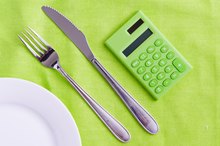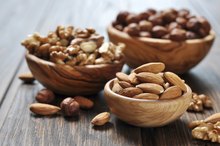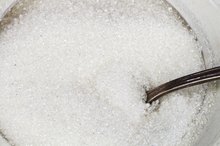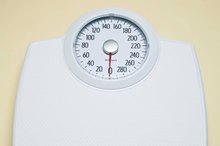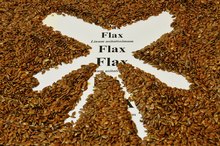How to Convert a Recipe for Carb Counting
If you are watching your carbohydrate intake, you need to have a sound understanding of the amount of carbohydrate, in grams, found in the food you routinely eat. Some people need to control their carbohydrate intake to keep their blood sugar levels in check, as with diabetes. Others stick to a low-carb eating plan to lose weight. Most of the time, the carb count of your favorite foods can be found on the nutrition label; otherwise, the carbohydrate content can be found in a food composition table or even in an online database. But what about your favorite recipes? If you enjoy cooking and baking, you can obtain the carbohydrate content of your favorite recipe with a few simple conversions.
Determine which ingredients contain carbohydrates in your recipe. If you don't need to know the calories, fat and protein content of a recipe, you can leave out some ingredients to make your work simpler and faster. For example, if your recipe has eggs, cheese, meat, poultry, fish, butter, heavy cream, oil, baking powder, baking soda and seasonings, you don't need to go through the next steps with these ingredients. However, ingredients such as flours, grains, legumes, vegetables, fruits, milk, yogurt and sugar provide significant sources of carbohydrates, so you will need to pay attention to these to convert your recipe to grams of carbohydrates.
How to Calculate Grams
Learn More
Find the carbohydrate and fiber content corresponding to the amount of each carbohydrate-containing ingredient found in your recipe. On a piece of paper or in a spreadsheet, list all the carbohydrate-containing ingredients of your recipe and the amount used. Then, with the help of a food composition table or online food database, such as can be found at nal.usda.gov, for example, figure out the amount of carbohydrates found in each of these ingredients 1. It is a good idea to list the fiber content at the same time, as fiber is part of the total carbohydrates -- although it is metabolized differently. Fiber does not contribute to elevating your blood sugar levels and does not provide calories, so some people prefer to subtract fiber from the total amount of carbohydrates to obtain what is called net carbs or available carbohydrates. Once you have listed the carbohydrate content of each of the carbohydrate-containing ingredients, add up the grams of carbohydrate -- and fiber if you wish -- found in the whole recipe.
Divide the total grams of carbohydrates in your whole recipe by the number of servings your recipe yields. For example, if you have determined that your batch of muffins, yielding a total of 12 muffins, contains a total of 204 g of carbohydrates and 24 g of fiber, it means that each muffin provides 17 g of carbohydrates and 2 g of fiber, which is the equivalent of 15 g of net carbs. Now you can use the carb count that you calculated for a serving of this recipe to track your carbohydrate intake.
Tips
Write it down. Add a note to your recipe specifying the amount of carbohydrates and fiber per serving, so you don't have to do the work all over again next time.
Warnings
Consult with your health care team or dietitian to estimate the appropriate carbohydrate intake you should aim for to maintain or improve your health.
Related Articles
References
- USDA National Nutrient Database: Nutrient Data Laboratory
- LiveStrong: The Daily Plate
- Brazeau AS, Mircescu H, Desjardins K, et al. Carbohydrate counting accuracy and blood glucose variability in adults with type 1 diabetes. Diabetes Res Clin Pract. 2013;99(1):19-23. doi:10.1016/j.diabres.2012.10.024
- Van Wyk HJ, Davis RE, Davies JS. A critical review of low-carbohydrate diets in people with Type 2 diabetes. Diabet Med. 2016;33(2):148-57. doi:10.1111/dme.12964
- Rabinovitz HR, Boaz M, Ganz T, et al. Big breakfast rich in protein and fat improves glycemic control in type 2 diabetics. Obesity (Silver Spring). 2014;22(5):E46-54. doi:10.1002/oby.20654
- Balić A, Vlašić D, Žužul K, Marinović B, Bukvić Mokos Z. Omega-3 Versus Omega-6 Polyunsaturated Fatty Acids in the Prevention and Treatment of Inflammatory Skin Diseases. Int J Mol Sci. 2020;21(3):741. doi:10.3390/ijms21030741
Tips
- Write it down. Add a note to your recipe specifying the amount of carbohydrates and fiber per serving, so you don't have to do the work all over again next time.
Writer Bio
Aglaee Jacob is a registered dietitian. She has experience working with people who have diabetes, cardiovascular disease, hypertension and obesity issues. Jacob obtained a bachelor of science and a master of science, both in nutrition, from Laval University in Quebec City, Canada.
